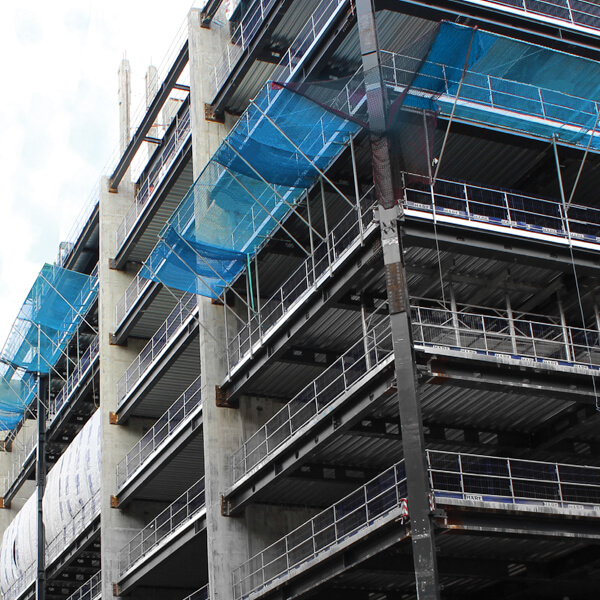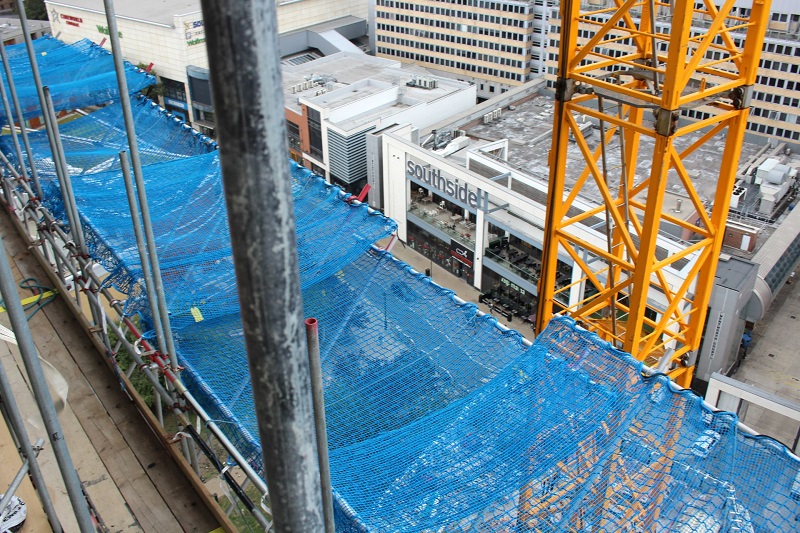High-rise innovation has been undeniably enabled by improvements in Edge Protection technology. These developments have been supported by the safety industry showing how important it is to future-proof our products.
Nowadays, Catchfans, Edge Protection and Fall Protection Systems are a common sight around construction sites in the UK. Still, if you think back to even as little as 50 years ago, health and safety standards were worlds away, particularly when it came to working at height. Whilst falls from height statistics are largely generated through falls from smaller heights (10ft or less), the increase in overall building heights has contributed to the need for protection from objects falling from a height, as well as workers.

City skylines began to change in 1931 when the Empire State Building’s 102 storeys (over 1,205ft) were completed in under two years, and at the time, there were no Catchfans, no Fall Protection Systems, and no laws in place to protect workers from the dangers of operating at height.
Over 3,000 people worked on the project, many of whom worked over a thousand feet in the air. These iron and steelworkers were dubbed “sky boys” and would balance on beams or hang from wires while they carried out their dangerous work, with large crowds below describing the sight as an open-air acrobat show. In view of the lack of safety equipment present at the time it is of course a surprise that there were not more than two fatalities. Still, it is clear that at this point, architecture and engineering were a few too many steps ahead of health and safety regulations.
London didn’t start building high rises until considerably later due to a London Building Act from 1894 that limited building heights to protect views of historical sites like St Paul’s Cathedral. This was only overturned in the late 20th century, and the skyline of our capital city gradually began climbing upwards, with the rest of the country’s large towns and cities following suit. Upwards growth has been unprecedented ever since with the last 30 years completely transforming the London skyline.

Taller buildings became commonplace, with mass-material production and new machinery making larger-scale construction easier. However, this progress in architecture and engineering couldn’t have been maintained if it wasn’t for the UK’s efforts in construction safety legislation.
The Health and Safety at Work Act (HSWA) 1974 changed the way workplaces looked at caring for their employees. This was one of the first pieces of legislation that legally obligated employers and employees alike to take action towards making the workplace a safer place. For the first time, an Act of Parliament enforced the regular maintenance and inspection of work equipment.
The HSWA 1974 is still a valued piece of legislation to this day, but it has been developed even further. The Work at Height Regulations 2005 was put in place as a foundation to be added to as times and procedures changed. They promote the clear principles of, firstly, avoiding work at heights wherever possible, secondly, preventing falls from height, and finally, minimising damage both to worker and civilian should a fall occur. This regulation includes all the information that should be needed to keep all employees and colleagues safe when working at height, including laying out guidelines for how often equipment should be inspected, the designation of rescue plans, and even stipulating particular products for specific tasks.
These legislative changes have been essential in improving safety records in high-rise construction. Figures from the Health & Safety Executive indicated that construction site fatalities have decreased year on year from 38 in 2017-18 to 30 in 2018-19 – the joint lowest on record. This report also finds that across all industries falls from height continue to be the most prevalent cause of death in the workplace with the third most evidenced being struck by a falling object. These two factors currently account for 38% of all workplace fatalities.
Working at height regulations have evolved vastly and have led to the development of personal Fall Protection Systems like our own Alsipercha, Alupercha, and Catchfans that can be designed to accommodate the most complex building design, to prevent workers or objects from falling too far should an accident occur. A lot of these solutions have been driven by recent sections of the 2005 Working at Height Regulation, which aims to promote safety by first identifying the dangers and then creating innovative ways to prevent them.
Recent developments in regulation have also changed the way that edge protection product such as barriers and guardrails are utilised. Under The Building Regulations, Part K 2013 guarding must consist of at least two horizontal rails and have a minimum height of 1100mm.
Artical from Vertemax
